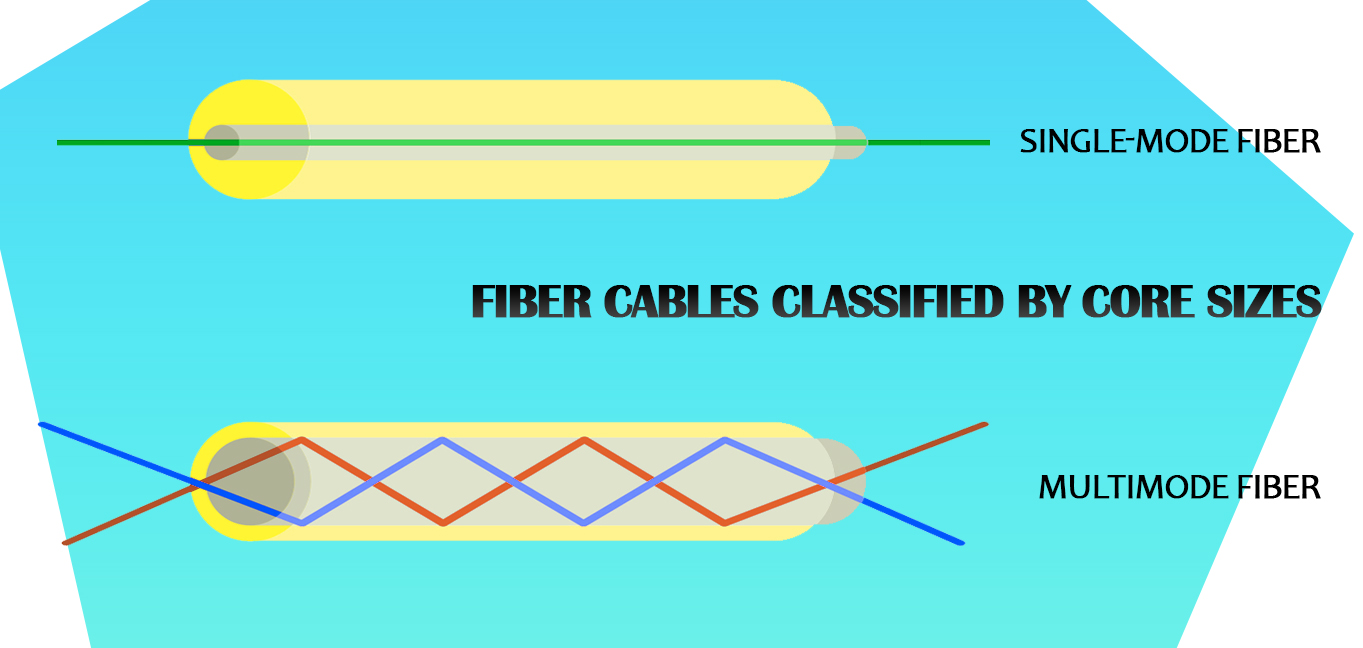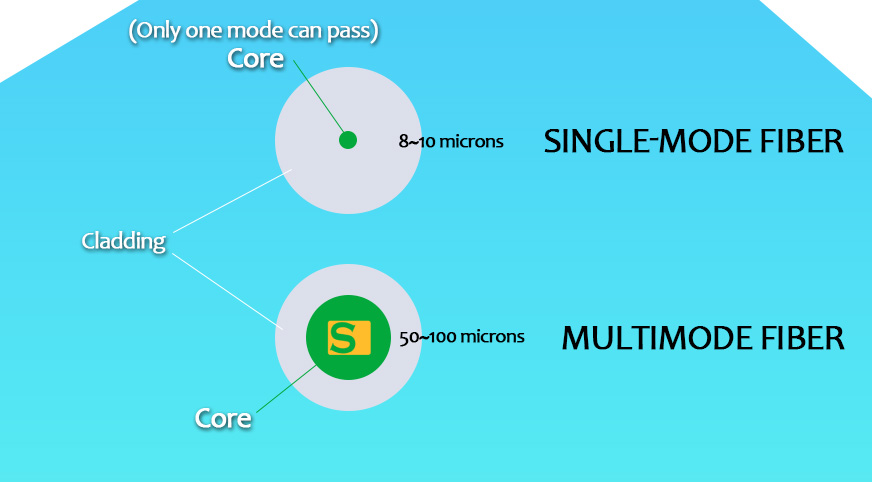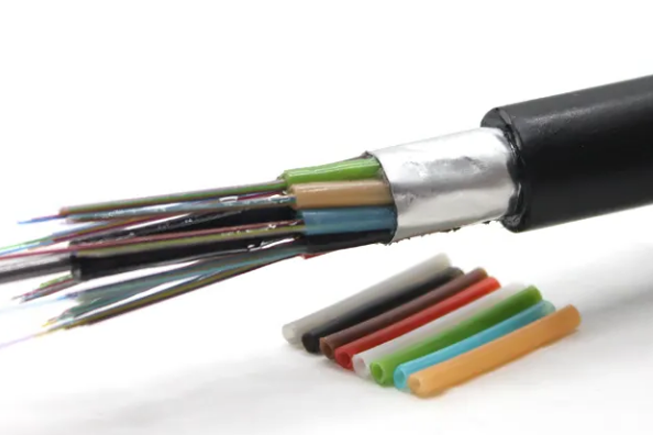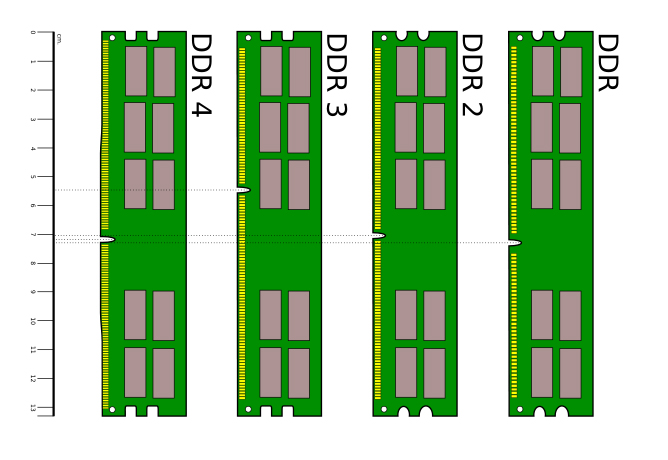
Single Mode vs. Multimode Fiber: Key Differences and How to Choose
1. Introduction
Fiber optic technology has revolutionized data transmission, offering unparalleled speed, reliability, and efficiency for modern networks. As businesses and organizations strive to meet growing bandwidth demands and ensure seamless communication, fiber optics has become the backbone of network infrastructure. However, selecting the right type of fiber—single mode (SMF) or multimode fiber (MMF)—is a critical decision that impacts performance, cost, and scalability.
The key difference lies in how these fibers transmit light. Single mode fibers use a narrow core to allow light to travel in a single pathway, making them ideal for long-distance, high-bandwidth applications. In contrast, multimode fibers feature a larger core that supports multiple light paths, making them more suitable for shorter distances and localized networks.
This article will explore the core differences between single mode and multimode fibers, including their performance, cost considerations, and practical use cases. By the end, you’ll have the knowledge to choose the best fiber optic solution for your network needs.
2. Key Differences Between Single Mode and Multimode Fiber
To understand which type of fiber optic cable is best suited for your needs, it's essential to explore the key differences between single mode and multimode fibers. These differences impact performance, range, and cost, making them critical factors in your decision-making process.
Core Size and Light Transmission
- Single Mode Fiber (SMF): With a small core diameter of 8-10 μm, single mode fiber allows light to travel along a single pathway. This minimizes signal reflection and dispersion, ensuring high signal integrity over long distances.
- Multimode Fiber (MMF): Featuring a larger core diameter of 50-100 μm, multimode fiber supports multiple light paths, or "modes," simultaneously. While this design enables easier alignment and installation, the overlapping light paths lead to greater modal dispersion, limiting its range and bandwidth.
Bandwidth
- Single Mode: SMF provides nearly unlimited bandwidth, making it ideal for applications requiring high-speed data transfer over vast distances. Its capability to handle massive data loads ensures future scalability.
- Multimode: MMF has lower bandwidth due to modal dispersion. However, it still offers sufficient capacity for short-range applications, such as Local Area Networks (LANs) or campus networks.
Distance
- Single Mode: Designed for long-distance transmission, single mode fibers can span distances of up to 100 kilometers or more without significant signal degradation, making them suitable for wide area networks (WANs) and intercontinental communication.
- Multimode: Best for shorter distances, multimode fibers are typically effective up to 300-550 meters, depending on the fiber grade (e.g., OM3 or OM4).
Attenuation
- Single Mode: SMF experiences lower attenuation, meaning less signal loss over long distances. This ensures reliable performance for applications requiring extended reach.
- Multimode: Due to its larger core and multiple light paths, MMF has higher attenuation, which becomes more pronounced as the transmission distance increases.
3. Cost Considerations
Cost is often a decisive factor when choosing between single mode and multimode fiber. While both types of fibers serve distinct purposes, their initial, operational, and equipment costs vary significantly, influencing your overall network investment.
Cable Cost
- Single Mode Fiber (SMF): Single mode cables are generally cheaper to manufacture due to their simpler design, which requires less material than multimode cables. This makes the raw cost of single mode cables slightly lower.
- Multimode Fiber (MMF): Multimode cables are more expensive to produce because their larger core diameter and optimized construction demand more materials and precise engineering.
Equipment Costs
- Single Mode: The equipment used with single mode fiber, such as transceivers and connectors, tends to be more expensive. This is because the precise alignment required for its small core demands higher-quality, laser-based light sources and advanced optical components.
- Multimode: Multimode fiber utilizes less expensive optics, such as LED or VCSEL (Vertical Cavity Surface Emitting Laser) light sources, making the overall system cost lower. This is particularly advantageous for budget-conscious projects with short-distance requirements.
Installation Costs
- Single Mode: Installation of single mode fiber requires greater expertise and precision due to its small core size and the need for laser alignment. This can increase the labor costs associated with deploying single mode networks.
- Multimode: Multimode fiber is easier to install and terminate in the field, thanks to its larger core, which allows for simpler alignment. This reduces the complexity of installation and the time required for setup.
Operational Costs
- Single Mode: While the initial equipment costs are higher, single mode fibers are more energy-efficient for long-distance transmission, requiring fewer repeaters and consuming less power over time. This makes them more cost-effective in large-scale or long-term deployments.
- Multimode: Multimode transceivers consume less power and are more suitable for short-distance applications, where the power savings can accumulate, particularly in data centers or localized networks.
Long-Term Value
- Single Mode: For applications with high bandwidth demands or plans for future scalability, single mode fiber provides better long-term value. Its ability to handle upgrades in speed and distance without replacing the physical cables ensures a lower total cost of ownership (TCO).
- Multimode: Although multimode fiber has higher operational limitations, it remains a cost-effective solution for short-distance applications, especially in environments with frequent moves, adds, and changes.
4. Applications and Use Cases
The choice between single mode and multimode fiber depends heavily on the specific requirements of your network, including distance, bandwidth, and operational environment. Below are the primary applications and use cases for each type of fiber.
Single Mode Fiber (SMF)
Single mode fiber is the preferred choice for scenarios requiring long-distance, high-speed, and high-capacity data transmission.
-
Telecommunications and Internet Backbones
- Used extensively for long-distance telecommunications and undersea cables.
- Forms the backbone of the internet, enabling high-capacity data transmission across continents.
-
Data Centers and Cloud Networks
- Essential for interconnecting data centers over large geographical areas.
- Supports high-speed links (10G, 40G, and beyond) with minimal signal loss.
-
Wide Area Networks (WANs)
- Ideal for interbuilding connections in campuses, enterprise WANs, and city-wide networks.
- Ensures stable performance over distances up to 100 kilometers or more.
-
Broadcast and Streaming
- Used in the transmission of high-definition video and live-streaming data across vast distances.
Multimode Fiber (MMF)
Multimode fiber is most effective for short-to-medium distance applications where cost and ease of installation are priorities.
-
- Common in enterprise and campus networks for connecting office spaces, meeting rooms, and IT systems.
- Sufficient for bandwidth-intensive applications within 300-550 meters.
-
Data Centers
- Frequently used for short-reach connections between racks and equipment within data centers.
- Supports high-speed links for storage, backup, and processing tasks.
-
Campus Networks
- Suitable for interbuilding connections within a single campus, such as universities, hospitals, and corporate facilities.
- Cost-effective for shorter distances.
-
Audiovisual Systems
- Often deployed in AV setups for transmitting video and audio data over short distances.
- Widely used in broadcasting studios, theaters, and large event spaces.
5. Advantages and Limitations
Understanding the strengths and weaknesses of single mode and multimode fiber helps ensure the right choice for your network’s specific needs. Here’s a breakdown of the advantages and limitations of both types.
Advantages of Single Mode Fiber (SMF)
-
High Bandwidth and Speed
- SMF supports nearly unlimited bandwidth and high data transfer rates, making it ideal for network-intensive applications such as 4K/8K video streaming, VoIP, and large-scale data processing.
-
Long-Distance Capability
- With low attenuation and minimal signal dispersion, SMF can transmit data over distances of up to 100 kilometers or more without significant loss.
-
Future-Proof
- Its capacity to handle increasing bandwidth demands ensures that SMF remains a scalable and long-term solution for growing networks.
-
High Signal Integrity
- SMF is less susceptible to modal dispersion, ensuring reliable performance even under high data loads or extended distances.
Limitations of Single Mode Fiber
-
Higher Equipment Costs
- The precision required for its small core necessitates expensive transceivers, laser-based light sources, and connectors.
-
Complex Installation
- SMF installation demands specialized skills and precise alignment, increasing deployment costs and complexity.
Advantages of Multimode Fiber (MMF)
-
Lower Equipment and Installation Costs
- MMF uses less expensive optics, such as LEDs and VCSELs, and its larger core makes installation and termination simpler.
-
Sufficient for Short Distances
- MMF provides adequate bandwidth and speed for short-to-medium range applications, such as Local Area Networks (LANs) and data centers.
-
Ease of Maintenance
- Its compatibility with field-installed connectors and less stringent alignment requirements simplifies ongoing maintenance.
-
Flexibility in Design
- MMF is more forgiving of bends and stress, offering better flexibility for complex routing within buildings or campuses.
Limitations of Multimode Fiber
-
Limited Distance and Bandwidth
- Modal dispersion limits its effectiveness beyond 300-550 meters and reduces its bandwidth compared to SMF.
-
Higher Signal Loss
- The larger core size and multiple light paths lead to higher attenuation, making MMF unsuitable for long-distance applications.
-
Less Future-Proof
- As bandwidth demands increase, MMF may not offer the scalability required for emerging technologies and high-speed applications.
| Feature | Single Mode Fiber (SMF) | Multimode Fiber (MMF) |
|---|---|---|
| Bandwidth | Virtually unlimited, high-speed | Sufficient for short-range use |
| Distance | Up to 100 km+ | 300-550 meters |
| Cost | Higher equipment costs, lower cable costs | Lower equipment costs, higher cable costs |
| Installation | Complex, requires precision | Easier and faster |
| Signal Integrity | Minimal loss and dispersion | Higher loss and dispersion |
| Best Use | Long-distance, high-performance networks | Short-distance, cost-sensitive setups |
Choosing the Right Fiber for Your Network
Selecting between single mode and multimode fiber depends on your network’s specific requirements, such as distance, bandwidth, budget, and future scalability. Below are key considerations to guide your decision:
Key Questions to Consider
-
What distance does the fiber need to cover?
- If your network spans long distances (e.g., interbuilding connections or WANs), single mode fiber is the better choice.
- For shorter, localized distances (e.g., within a data center or office), multimode fiber is sufficient.
-
What bandwidth does the network require?
- Applications requiring high-speed data transfer, such as 4K/8K video streaming or cloud computing, benefit from single mode fiber.
- Multimode fiber provides adequate bandwidth for typical LAN or campus network needs.
-
What is the budget for installation and equipment?
- Single mode fiber has higher upfront equipment costs but offers better long-term scalability.
- Multimode fiber is more cost-effective for short-term or smaller-scale networks.
-
What are the future needs of the network?
- Single mode fiber is a future-proof solution, supporting evolving bandwidth and distance demands.
- Multimode fiber is practical for current needs but may require upgrades as technology evolves.
General Recommendations
-
Choose Single Mode Fiber if:
- Your network spans long distances.
- High bandwidth and speed are critical.
- Scalability for future upgrades is a priority.
-
Choose Multimode Fiber if:
- The installation is localized or short-range.
- Cost and ease of installation are key considerations.
- Current bandwidth needs are moderate.
Conclusion
Selecting the right fiber optic cable—single mode or multimode—is essential to building an efficient, cost-effective, and future-ready network. Each type of fiber has its distinct advantages and limitations, making it suitable for different scenarios:
-
Single Mode Fiber (SMF): Ideal for long-distance, high-bandwidth applications such as telecommunications, data center backbones, and interbuilding networks. Its scalability and superior performance make it a future-proof investment, though it comes with higher equipment and installation costs.
-
Multimode Fiber (MMF): Best suited for short-distance, cost-sensitive setups like LANs, campus networks, and audiovisual systems. It offers easy installation and sufficient bandwidth for localized environments but is less effective over long distances.
By carefully evaluating your network’s distance, bandwidth needs, and budget, you can determine the fiber type that aligns with your current and future requirements. While multimode fiber provides an economical solution for short-term needs, single mode fiber ensures scalability and long-term value for high-performance networks.
At Stanford Optics, we specialize in providing high-quality fiber optic solutions tailored to meet diverse infrastructure demands. Whether you need single mode or multimode fiber, our team is ready to help you design and implement a reliable, efficient network. Contact us today to learn how we can support your connectivity goals.






